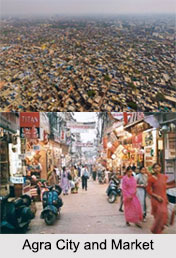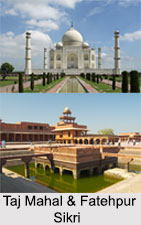 Agra is noted for the vibrant culture, rich medieval history from Delhi Sultanate era, and the monuments of Mughal era, with intricate art and architecture, which is now under the list of World Heritage Sites by UNESCO. This medieval city in Uttar Pradesh is also filled with graveyards and stones.
Agra is noted for the vibrant culture, rich medieval history from Delhi Sultanate era, and the monuments of Mughal era, with intricate art and architecture, which is now under the list of World Heritage Sites by UNESCO. This medieval city in Uttar Pradesh is also filled with graveyards and stones.
History of Agra
Agra finds its reference in the Mahabharata, where it is mentioned as "Agrabana". Ptolemy, the famous 2nd century geographer marked it on his map as Agra. It is believed that Sultan Sikandar Lodi, the Ruler of Delhi Sultanate founded Agra as the Muslim capital in the year 1504. The Mughal Emperor like Babur,akbar, Jahangir, and Shah Jahan prospered Agra by erected the gardens, monuments and the educational centers. Later, in 1653 AD, Aurangzeb shifted his capital to Aurangabad which now located in Aurangabad District of Maharashtra. 
Geography of Agra
Agra is situated on the banks of the Yamuna River in Agra District of Uttar Pradesh. On the north, Agra is bounded by Mathura, on the south by Dhaulpur, on the east by Firozabad district, on the south-east by Fatehabad district and on the west by Bharatpur district.
Climate of Agra
The climate of Agra is tropical in nature. It is prone to extreme temperatures. The temperature rises to 45 degree celsius during the summer and as low as 30 degree celsius in the winter. Agra experiences advance monsoon and retreating monsoon between June and September and an annual rainfall of 26 inches.
Demography of Agra
According to the Population census that was recorded in the year 2011, the population of Agra city was 1,585,704. The males constitute 53 percent and the females 47 percent. The concentration of Hindus and Muslims are the most in Agra. The sex ratio of Agra was 875 females per 1000 males. The child sex ratio stood at 857.
Education of Agra
Agra has many educational institutions. The average literacy rate of Agra was 73.11 percent. The literacy rate of males in Agra is considerably higher than that of women. It is the city where Hindu cult of education, Islamic education and British missionary education are dominant. Dr. Bhim Rao Ambedkar University, Sachdeva Institute of Technology, Sarojini Naidu Medical College and Agra College are popular educational institutions here.
Culture of Agra
Agra is an amalgamation of rustic and modern lifestyle. Here the culture can be described as amalgamation of Brij culture and Mughal culture. Agra is dominated by Jats and Yadavas Community. Agra celebrates Id-ul-Fitr, Id-ul-Zuha, Muharrum, Diwali and Taj Mahotsav. Cuisine of Agra is concentrated with Mughal dishes and sweets (Pethas).
Economy of Agra
The economy of Agra is based on agriculture, small scale industries and other trades. Wheat, mustard, Paddy, Bajra, Potato are the main generator of economy. The leather craft, handicrafts, zardozi, marble sculptures and stone crafts and inlay works are well prospered in Agra from the medieval era.
Tourism of Agra
Agra is well admired for the rapturous beauty and grandeur. Agra with its Taj Mahal is one of the famous tourist spots of the world. Agra Fort, monuments of Sikandara, Itmad-Ud-Daulah`s Tomb, Fatehpur Sikri, Radha Swami Samadhi, Mariyam`s Tomb and Chinni Ka Roja are the popular tourism attractions here.



















